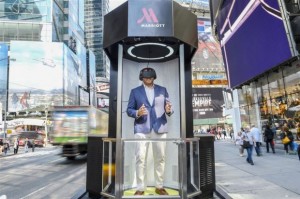A recent article published by AdAge discusses the latest addition to Marriott’s “Travel Brilliantly” marketing campaign: a ‘teleporter’ that uses virtual reality to transport consumers to locations such as a sandy beach in Hawaii, or the top of one of London’s highest buildings. The teleporter relies on technology by Oculus Rift and 3-D, 360 live action video by VFX studio Framestore (of Gravity fame), and can even simulate the mist and wind that would be felt atop of London’s Tower 42. The teleporters will be touring through nine U.S. cities including New York and San Francisco, September through November.
At a time when achieving meaningful consumer engagement is becoming increasingly difficult, Marriott’s teleporters create a new and unexpected way for consumers to interact with the brand. I imagine that this must be especially difficult for hotels, which for much time have had to rely on website photos and 360-degree videos (which can be surprisingly inaccurate, from my experience) to attract customers. I can see virtual reality technology playing a large role in the travel and hospitality industry in the future, especially for purchases where consumer experience is hard to explain, but is a major selling point.
Equally as impressive as Marriott’s teleporter is the amount of earned media attention that Marriott has received since the campaign was announced on September 18th, on numerous news websites, marketing blogs, and of course, social media.
But, the big question that I have about the campaign is, how will Marriott convert this virtual reality marketing into hotel stays? Sure, the Marriott teleporters might make the consumer want to go to London or Hawaii… but will they choose to stay at a Marriott? I’m not convinced that the connection is strong enough to actually increase room sales – and I assume that this is, in part, an objective for this campaign.
